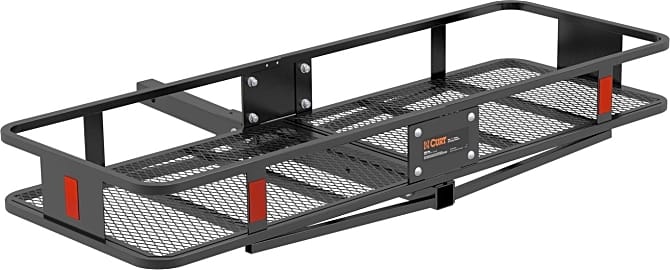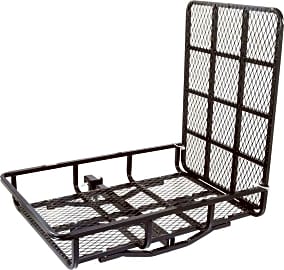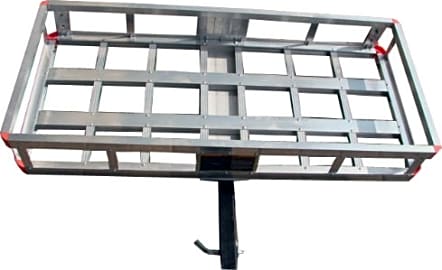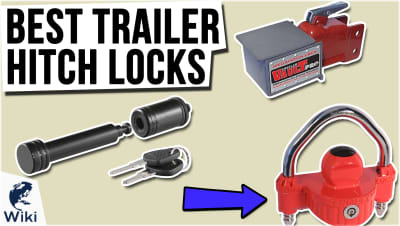The 10 Best Hitch Cargo Carriers

This wiki has been updated 42 times since it was first published in August of 2015. One of the major headaches associated with traveling is coming up with a way to haul all of the cargo you want to transport from point A to point B in a safe, convenient manner. Whether you need a platform to transport landscaping equipment, camping gear, bicycles, or other bulky items that won't fit inside your vehicle, one of these hitch racks should serve as a reliable solution. When users buy our independently chosen editorial recommendations, we may earn commissions to help fund the Wiki.
Editor's Notes
February 12, 2021:
Unfortunately, we had to remove the Rage Powersports Apex 3-Bicycle due to availability issues during this update. However, we were big fans of the design that allowed you to take a few bicycles along with other cargo on your trips, so we replaced it with the Apex BCCB-1169, which also offers that ability. Other than that, we did make a few changes to our rankings based on functionality and overall convenience of the carrier which saw some models, like the Rola Vortex getting a stronger recommendation, and others, such as the Northbound Aluminum Hauler, getting a bit less favor. We appreciate the former for its sleek style and license plate attachment point, while we felt the former's industrial look can detract from a vehicle's appearance, not to mention it lacked reflectors and had squared rails that could potentially scratch a person or equipment when loading it onto the unit.
August 20, 2019:
While much of our last ranking has remained intact, a few superior models have come along to oust a pair of underperforming options from the list. The first newcomer landed at number one in the form of the Northbound Aluminum Hauler, which is an extremely heavy duty option. The second landed at number four in the form of the Rage Powersports Combo. That's a unit with an extended arm capable of toting a trio of bicycles with you in addition to whatever you can fit into it large mesh rack. Out old number one item is one of the two that bit the dust, as it began to wobble a bit too much when approaching its maximum weight limit, likely a result of its welding design. The other was the Tow Tuff model previously at number ten, which presented a few assembly issues and was prone to rusting if left out for extended periods.
Rooftop Vs. Hitch Cargo Carriers
What you might not know is that the hitch cargo carriers offer a number of advantages over the rooftop cargo carriers that are so often seen on cars and SUVs.
You might already know that a hitch cargo carrier is a great way to travel with your luggage and other important items and still save space in your vehicle. What you might not know is that the hitch cargo carriers offer a number of advantages over the rooftop cargo carriers that are so often seen on cars and SUVs.
First, hitch cargo carriers offer a level of convenience and versatility that just isn’t possible with a rooftop cargo carrier. Using a rooftop carrier makes it difficult to access your items in a pinch. A hitch cargo carrier keeps everything at waist-level so you can access anything easily.
Second, rooftop cargo carriers often require additional materials such as mounting brackets in order to properly secure them. A hitch cargo carrier requires one thing: a trailer hitch. The great news about this is that most vehicles, especially trucks and SUVs, already come equipped with a ready-to-use trailer hitch.
The third advantage to the hitch cargo carrier is storage space. Since the rooftop carriers can only utilize a narrow, limited space, only certain types of items and luggage can be stored. Because hitch cargo carriers have a rectangular shape and sides that are generally raised five inches or more, they allow for better stability and secure storage of items that would be too bulky for the rooftop carrier.
Finally, the wind resistance created by using a rooftop cargo carrier can actually decrease the gas mileage you get. Because the hitch cargo carrier sits on the back, it adds a small amount of weight, but it will not add the wind resistance of a rooftop carrier meaning that there will be very little difference in your gas mileage.
It's Easier Than It Seems
When shopping for a hitch cargo carrier, you might be overwhelmed by the number of options available. The truth is, the decision-making process can be quite simple if you know how you plan to use it. Once you have determined your intended use, you can begin to consider other factors.
Unfortunately, it does not have the same weight capacity as steel or aluminum.
First, consider the type of material you prefer. Hitch cargo carriers are made with either steel, aluminum, or polypropylene. Most are made from steel as this tends to be both durable and affordable. Manufacturers coat the steel with a black powder that helps to protect it from the elements. Polypropylene is a type of durable plastic that is also lightweight. Unfortunately, it does not have the same weight capacity as steel or aluminum. The highest quality carriers are made from aluminum because it is both lightweight and rust resistant.
Second, consider the weight capacity. Depending on what you intend to transport, you might need a high weight capacity. Many steel carriers have a maximum weight capacity of 500 pounds making them ideal for loading and transporting equipment such as generators and lawn mowers. If you plan to use your carrier for travel, you can likely opt for a lighter option.
Third, check for compatibility with your vehicle’s trailer hitch. Most trailer hitches on SUVs and trucks are Class III or Class IV hitches, and most hitch cargo carriers are compatible with both. Don’t just assume, however, or you could find yourself dealing with more hassle than necessary.
You also have the choice between a solid or mesh platform. The advantage to a solid surface is that the cargo you’re carrying will be protected from debris that can kick up from the road. However, the mesh surface tends to be more popular because it provides openings for better securing items with cargo straps.
Finally, there are a number of accessories available with hitch cargo carriers. These can include ramps for easy loading of heavy items and equipment and lighting kits and reflectors for safe night driving. Some carriers intended to for long-term, frequent use come complete with space for attaching a license plate.
A Brief History of the Hitch Cargo Carrier
The first trailer in recorded history was the cart which originated around 5000 B.C.E. It was a two-wheeled vehicle built soon after the invention of the wheel. It was pulled by domesticated animals including horses, oxen, and donkeys. It was used to transport personal belongings and crops.
Since automobiles are now an essential part of everyday life, trailers are still in use but in a different way.
The next step in the evolution of the trailer was the chariot. It was invented around 3000 B.C.E. and was drawn by horses. The early Mesopotamians developed it as a status symbol, and it was used by royalty and members of the upper class.
Centuries later, around 800 C.E., the chariot evolved into the sleigh. It appears that it was first used by Vikings for both work and play and was preferred in cold climates because it was safer and more convenient than wheeled vehicles on ice, mud, and snow.
The covered wagon made its appearance in the mid-eighteenth century, and the largest among them could carry up to 12,000 pounds of cargo at one time. They were first used by German settlers in what is now the United States and were pulled by horses or oxen.
Since automobiles are now an essential part of everyday life, trailers are still in use but in a different way. Many people still find the need to haul important items while saving space inside the vehicle. Trailers that hitched to the back of the car were the solution to this need for a long time. Now we have the convenience of hitch cargo carriers that don’t require additional maneuvering and simply act as a part of the vehicle itself.















